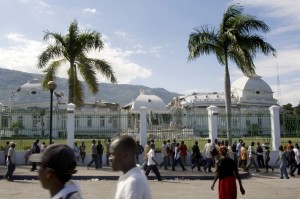 In most countries, the White House (so to speak) embodies a government’s power and authority in that land. Through its grandeur, the structure also evokes a sense of national pride and identity among the citizenry. This premise was no different for Haitians in terms of the Haitian National Palace. Designed by Haitian architect George Baussan in 1912, and completed by the United States’ during its occupation of Haiti from 1915-1934, the palace was once thought to be invincible. After the earthquake two and a half years ago, the crumbled palace now stands as a constant reminder of the government’s inability to fully emerge from this disaster.
In most countries, the White House (so to speak) embodies a government’s power and authority in that land. Through its grandeur, the structure also evokes a sense of national pride and identity among the citizenry. This premise was no different for Haitians in terms of the Haitian National Palace. Designed by Haitian architect George Baussan in 1912, and completed by the United States’ during its occupation of Haiti from 1915-1934, the palace was once thought to be invincible. After the earthquake two and a half years ago, the crumbled palace now stands as a constant reminder of the government’s inability to fully emerge from this disaster.
Despite this, last week’s sudden announcement that Sean Penn’s charity is demolishing the Haitian National Palace caught me completely off guard. Less than twenty-four hours after the news surfaced, an official ceremony revealed that demolition would begin in a few days and last about two to three months. The fact that the national palace is being destroyed in its entirety, even though a previous assessment found that it could actually be restored, is not what most surprised me. I am astounded that such a monumental building is going down without a calculated plan for what’s next.
 It is unfathomable to imagine something like this occurring in the United States or in other major countries of the world. At the minimum, construction projects do not move forward without an on-site placard that details the organization responsible for the project, which government entity is overseeing it, a picture of what the edifice will eventually look like and an expected completion date. It is actually required by law so that the general public remains informed of ongoing development projects. If demolition is indeed the final determination for the Haitian National Palace, it would make sense to wait at least until this basic information is available and a project plan has been developed.
It is unfathomable to imagine something like this occurring in the United States or in other major countries of the world. At the minimum, construction projects do not move forward without an on-site placard that details the organization responsible for the project, which government entity is overseeing it, a picture of what the edifice will eventually look like and an expected completion date. It is actually required by law so that the general public remains informed of ongoing development projects. If demolition is indeed the final determination for the Haitian National Palace, it would make sense to wait at least until this basic information is available and a project plan has been developed.
The news of the demolition was also disturbing in that it did not come with a commitment to engaging Haitian design professionals. Often times, because Haiti relies so heavily on international assistance, external entities and individuals are able to wield more influence over Haiti’s present and future affairs than its own people. The situation over the palace is the latest example of this reality. In the same manner that Mr. Baussan’s 20thcentury rendering for the national palace emerged from a design competition, Mr. Penn and the Haitian government should provide a similar opportunity for modern-day Haitian professionals. Haitian architects and designers should be able to contribute their leadership and skillsets towards this historic rebuilding.
I understand the pressing need to uphold Haiti’s public image and to restore its collective psyche. If demolition is pushed along without a follow up strategy however, it will be too easy for a project of this nature to stall. When all is said and done, if the crumbled palace currently stands as a national embarrassment, without a plan or a timeline for completion, I wonder what no national palace will symbolize for Haiti and for how long.
Nevertheless, I look to the prospect of holding the new Haitian National Palace in high esteem one day. My hope is that more thought will be given to how the palace will be restored – before, during and after demolition.
As originally featured in the Urban Times.


About The Author: Vanessa L.
More posts by Vanessa L.